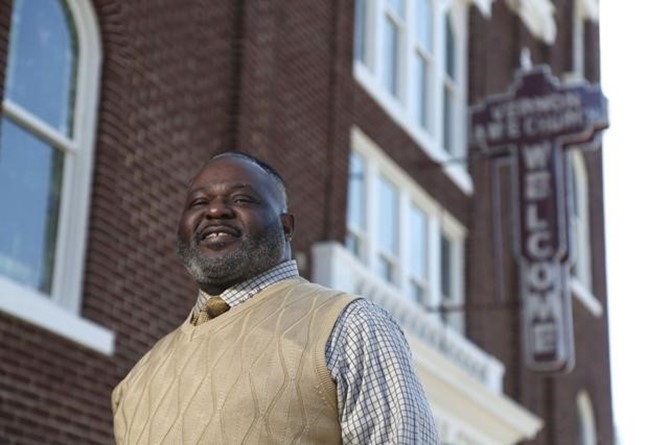By Kristi Orisabiyi Williams
Historic Vernon African Methodist Church, nestled in the heart of Tulsa, Oklahoma, within the vibrant districts of Greenwood and Black Wall Street, stands as a testament to the community’s resilience, reinvigoration, and enduring spirit. This sacred haven played a pivotal role during the dark days of the 1921 Tulsa Race Massacre, as its basement provided refuge and solace for the residents of Greenwood. The story of Vernon AME Church has resonated with people worldwide, even making its mark in the movie “Killers of The Blood Flower Moon,” where the church’s fiery trial during the massacre is poignantly portrayed by renowned actors Robert De Niro and Leonardo DiCaprio.
The history of Vernon AME Church traces its origins back to the year 1905 when Reverend J.E. Roy laid its foundations as a humble one-room church at 549 Detroit Ave in Greenwood. The church experienced rapid growth in its initial three years, prompting multiple relocations. In 1908, under the stewardship of Reverend James Johnson, Vernon found its enduring home, the very site it occupies today. The church, initially a modest one-story structure, was later bestowed with the name of William T. Vernon, who, in 1906, made history as the first African American.
Registrar of the Treasury under President Theodore Roosevelt. In 1914, the visionary Reverend C.R. Tucker embarked on an ambitious endeavor to replace the one-story church with an imposing three-story structure that would symbolize pride for generations to come. Reverend Tucker insisted on the construction of a robust brick basement. Little did they foresee that this basement would not only shield Greenwood’s residents during a time of turmoil but continue to stand strong as a poignant testament to their unwavering legacy.
Following the devastation of the 1921 Tulsa Race Massacre, Reverend C.R. Tucker did not return. In his absence, Reverend W.C.B. Lewis took on the role of supply pastor, providing steadfast guidance during the community’s challenging days. His dedicated service continued until December 31, 1921.
In the spirit of resilience and communal strength, a commendable effort was launched to rebuild the beloved church’s basement. At that time, the Trustee treasury held $3,000, and the California Conference, under the leadership of Bishop H.B. Parks, generously contributed $400. These funds played a pivotal role in reconstructing and revitalizing Vernon’s sacred space—the basement.
This historical note is a testament to the community’s unwavering determination and unity. It stands as a shining example that they united to rebuild and fortify their foundations even in the face of adversity.
On October 21, 2022, Bishop Michael L. Mitchell, recognizing the remarkable abilities of Rev. Keith R. Mayes, Sr., decided to transfer him from the 7th Episcopal District to the hallowed grounds of the Historic Vernon AME Church on Black Wall Street.
The Reverend Mayes, with an impressive track record, had previously led the High Hills AME Church in Dalzell, South Carolina, through a breathtaking total redesign and renovation project. His role extended beyond spiritual guidance, as he served as the architectural designer and general contractor. The culmination of his dedication and hard work was celebrated on June 30, 2019, when Bishop Samuel L. Green, Sr. dedicated the newly transformed church.
Upon his arrival at Vernon, the Rev. Mayes brought the same determination and vision for restoration and revitalization. He aimed not only to nurture the souls of the congregation but also to breathe new life into the proud historic facility known as the Grandmother of Greenwood.
The spiritual and numerical growth at the church was evident from the moment the Rev. Mayes stepped in. A beautiful prayer wall was constructed during his first year, symbolizing unity and faith that inspires the congregation.
The journey of beautification and restoration began with a striking three-section masonry flower bed gracing the church’s front. It was a testament to the care and attention to detail that Rev. Mayes and his team poured into their work. This was just the beginning.
Soon after, the church witnessed further enhancements, such as the installation of a sprinkler system and the renovation of Faith Hall. The crowning achievement, a 22,000-square-foot parking lot, underwent a total reconstruction, making it not only functional but also an asset to the community.
Under the Rev. Mayes’s guidance, Vernon AME Church transcends the confines of physical space. It serves as a sanctuary for mending relationships, bridging divides, and infusing the community with a spirit of unity and healing. The Reverend Mayes has been the catalyst for uniting diverse individuals, each contributing their unique talents and experiences.
As we venture deeper into the living history of Vernon AME, we continue to unearth more about the profound legacy of the beloved church. Named after William T. Vernon, the first African American appointed by President Theodore Roosevelt in 1906 as Registrar of the Treasury, the church also boasts an intriguing connection to the legendary Jackson family, particularly Samuel S.M. Jackson, the Great Uncle of the iconic Jackson 5. He served as a Trustee of Vernon AME Church, and his name is engraved in one of the beautiful stained glass windows before you get to the sanctuary. During the 1921 Tulsa Race Massacre, Samuel S.M Jackson was the sole funeral director, demonstrating unwavering commitment to the community. Following the tragedy, Vernon AME held a service on the Sunday afterward but found themselves without chairs. In an extraordinary act of generosity, Samuel Jackson donated chairs from his funeral home, which continue to be cherished in Vernon’s Prayer Room.
Sources: The Victory of Greenwood Carlos Moreno & Savingplaces.org



